AiPrise
8 min read
September 30, 2025
Understanding User Identity Verification Process
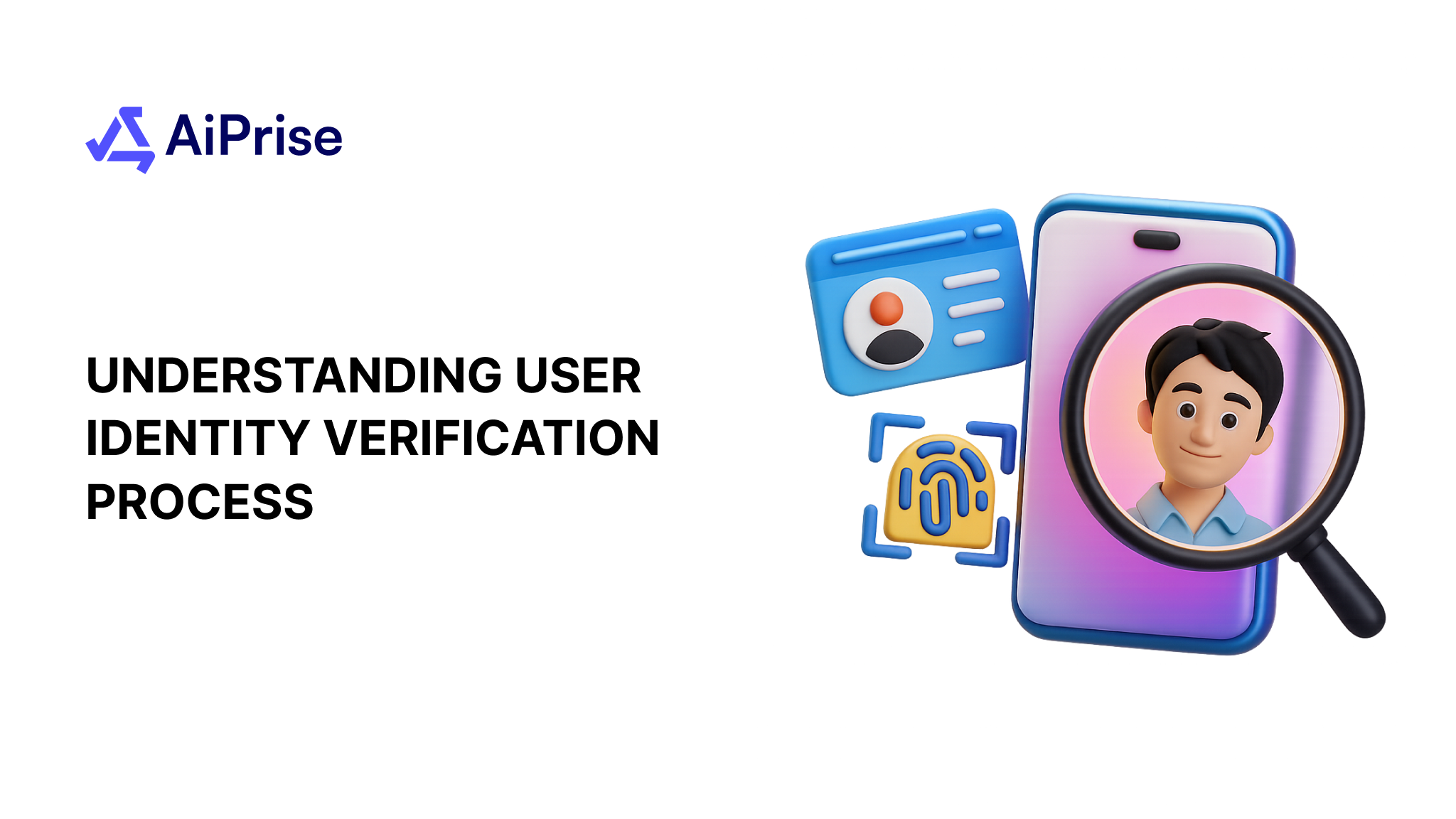
Key Takeaways










Have you ever had to verify your identity when opening a bank account, signing up for an online service, or even purchasing a high-value item? It’s something most of us have experienced at some point, and it’s become a standard part of conducting business. But have you ever stopped to wonder what "identity verification" really means, and why it’s so important, not just for consumers, but for your business as well?
In this blog, we’ll understand the concept of identity verification, what it is, why it's such an important step for businesses, and how you can ensure your verification processes are secure, reliable, and efficient. By understanding this process, you’ll be better equipped to safeguard your business, enhance customer confidence, and stay ahead of potential risks.
Key Takeaways
- What is Identity Verification? It’s the process of confirming a person’s identity using personal details, official documents, or biometric data.
- Why is it Important? It prevents fraud, ensures compliance, protects data, and builds trust with customers.
- Steps in the Process: It includes collecting information, submitting documents, validating them, and checking against databases.
- Where It’s Used: Identity verification is used in banking, online shopping, healthcare, and other areas to ensure security.
- Challenges: Fraudulent documents, privacy concerns, and keeping up with changing regulations can make verification tricky.
What is Identity Verification?
You’ve probably gone through identity verification countless times in your life without even thinking about it. Whether it’s when you apply for a credit card, sign up for an online marketplace, or verify your account at the bank, you've had to prove you are who you say you are.
Identity verification is the process of validating that an individual is who they say they are. It typically involves checking personal details against official records and is used to prevent fraud and ensure the legitimacy of transactions.
Importance of ID Verification
- Fraud Prevention: It helps protect against identity theft, preventing criminals from impersonating legitimate users.
- Compliance with Laws: Many industries require businesses to verify identities as part of regulations like KYC (Know Your Customer) and AML (Anti-Money Laundering).
- Trust Building: Customers feel secure knowing that their personal data is being handled responsibly and that they’re engaging with legitimate entities.
- Operational Efficiency: Proper verification prevents fraud from entering your system, reducing the risk of chargebacks, false claims, and financial losses.
- Access Control: It guarantees that only authorized individuals are granted access to sensitive systems, data, or services.
As we’ve seen, identity verification plays a key role in security, fraud prevention, and regulatory compliance. Now, let’s understand the actual user identity verification process to see how these steps come together.
Facing increasing fraud risks? AiPrise offers the reliability and flexibility to protect data and ensure global compliance. Learn more: Why AiPrise Is the Reliable Platform for Identity Verification?
User Identity Verification Process
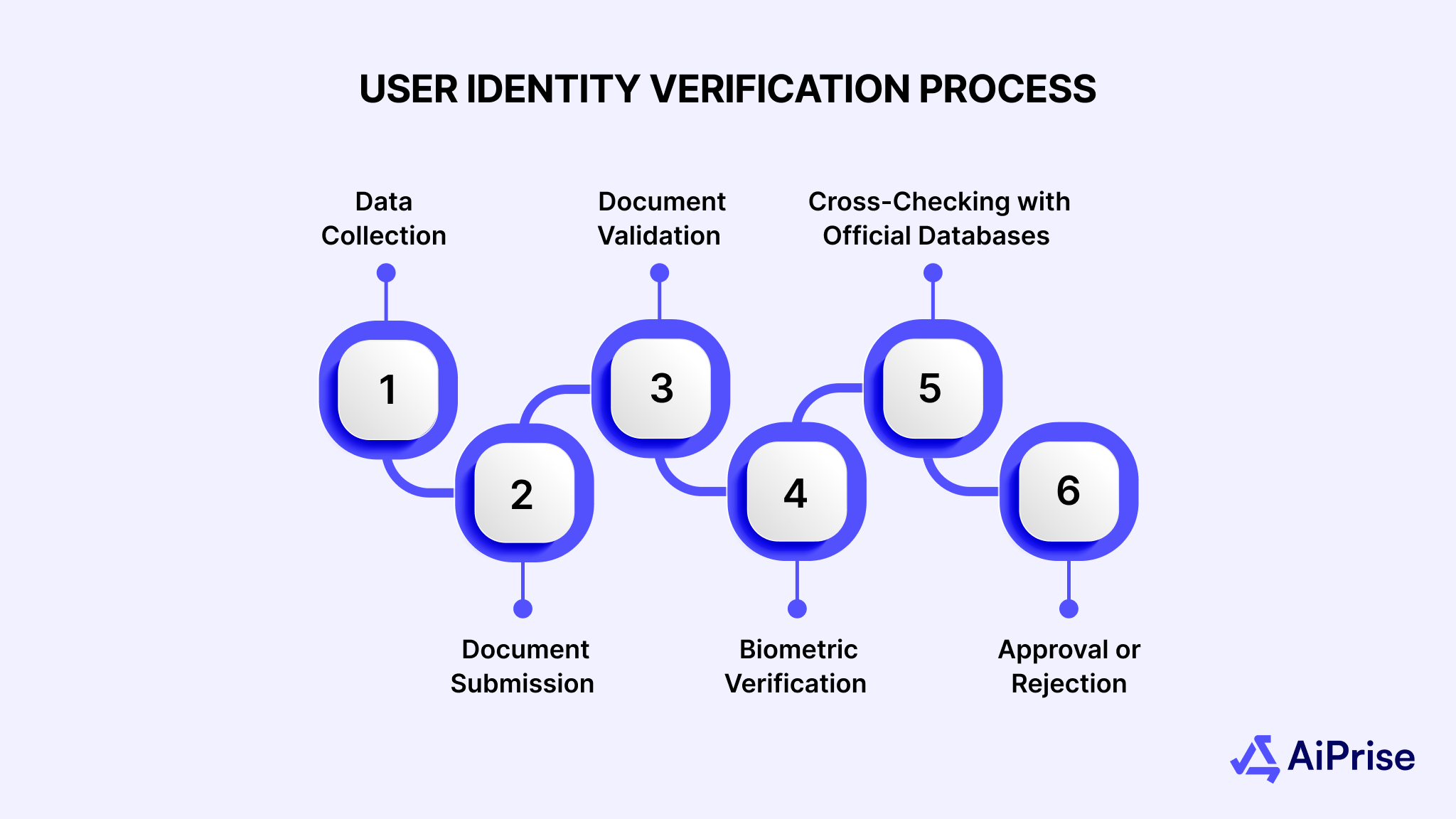
At first glance, the identity verification process may seem like just a routine task, but in reality, it’s an important multi-step process that ensures the person you’re interacting with is really who they say they are. This process plays a major role in preventing fraud, protecting personal data, and ensuring security.
Here’s how the process works:
1. Data Collection
The first step involves gathering the user’s personal details. This often includes information like their full name, date of birth, address, and government-issued ID numbers. The more information you collect, the stronger the verification process will be.
2. Document Submission
Once the personal information is provided, the user is asked to submit an official document to confirm their identity. Common documents include a passport, driver’s license, or national ID card. These documents serve as the official proof that the person is who they claim to be.
3. Document Validation
After the user submits their identification document, it’s verified for authenticity. This step can include checking for security features such as holograms, watermarks, or barcodes. Advanced verification tools, including AI-driven systems or third-party verification services, can also be used to detect if a document is real or fraudulent.
4. Biometric Verification (Optional)
In certain cases, an extra layer of security may be added in the form of biometric verification. This could include facial recognition or fingerprint scanning. The system compares the image on the submitted ID with a live photo of the user to ensure they match, adding an extra layer of accuracy.
5. Cross-Checking with Official Databases
To further verify the user’s identity, the information they provided is cross-checked with official databases. This could include government databases, credit agencies, or other trusted sources. The aim is to confirm that the details provided are consistent with official records.
6. Approval or Rejection
Once all the steps are complete, the system will either approve or reject the user’s request. If everything checks out, the user is granted access. However, if the system detects any discrepancies or signs of fraudulent activity, the verification process is either halted, or the user may be asked to provide further documentation to resolve the issue.
The process seems simple, but ensuring that it’s done correctly is important to avoiding fraud and ensuring compliance. Now, let’s look at how identity verification is applied in real-world scenarios to understand its practical implications.
Looking to strengthen your identity verification process? AiPrise offers advanced, reliable solutions to protect your business and build customer trust. Contact us now!
Real-World Examples
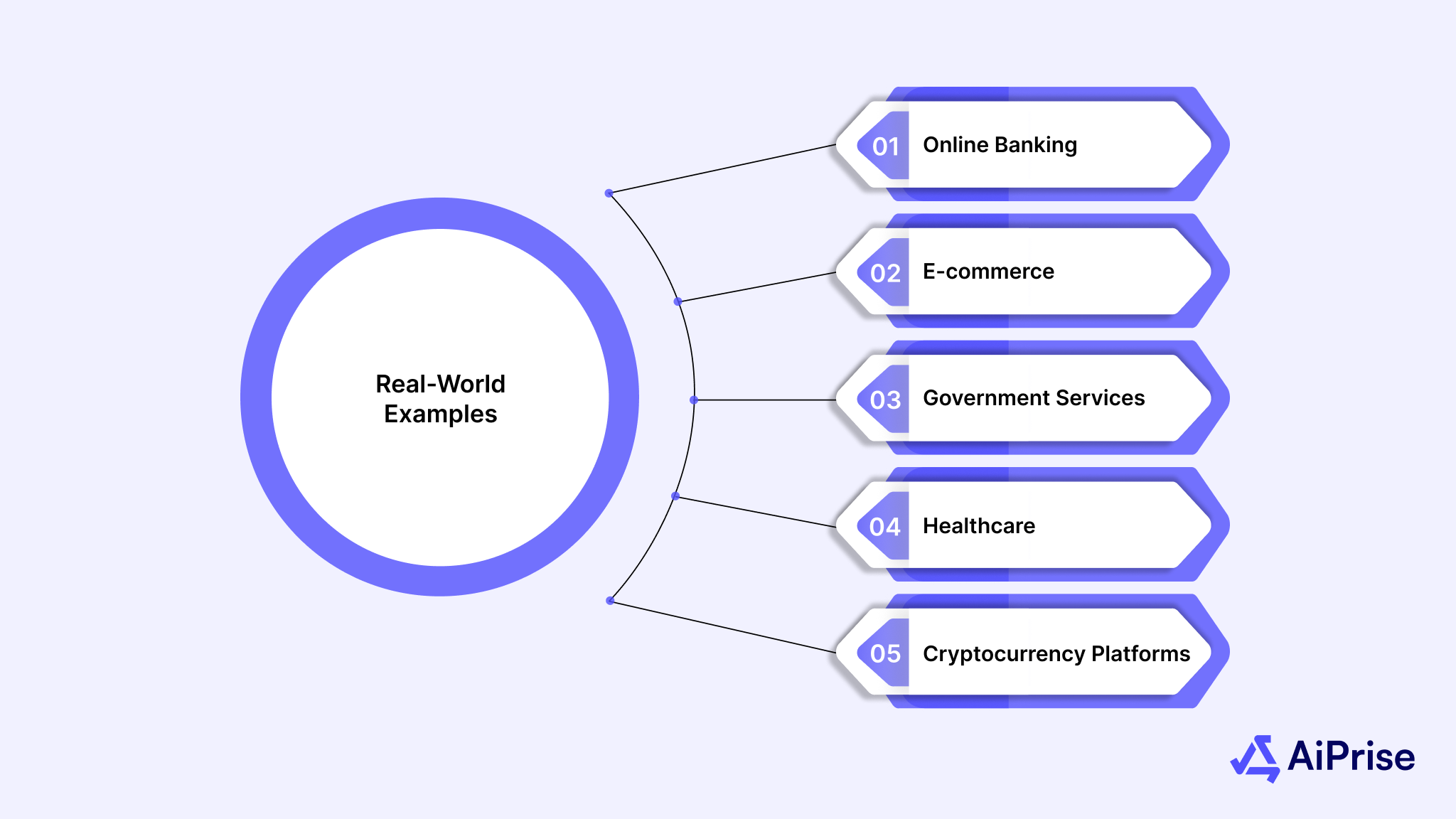
Understanding the theory behind user identity verification is one thing, but real-world applications can help make the process clearer. Here are a few examples of how identity verification is used across different industries:
1. Online Banking
Banks require customers to verify their identity when opening new accounts or making large transactions. This ensures that the person requesting the transaction or opening the account is genuinely who they claim to be, protecting both the bank and its customers from identity theft or fraud.
2. E-commerce
Online marketplaces often ask sellers and buyers to verify their identities to prevent fraudulent activities like fake reviews, selling counterfeit products, or creating fraudulent accounts. For example, a buyer may need to confirm their identity when purchasing high-value goods to ensure they aren’t engaging in fraud.
3. Government Services
When dealing with government benefits or services, citizens often go through identity verification to ensure only eligible individuals can use the services. For instance, receiving unemployment benefits or applying for a driver's license involves verifying your identity against official records.
4. Healthcare
In the healthcare sector, identity verification ensures that only an authorized person can access sensitive medical data or request prescriptions. It protects patient confidentiality, ensures accurate handling of medical records. This is important for HIPAA compliance and safeguarding patient data from unauthorized access.
5. Cryptocurrency Platforms
Cryptocurrency exchanges are required to follow strict Know Your Customer (KYC) regulations. To comply, they ask users to verify their identities before engaging in trading. This prevents money laundering and ensures a safer trading environment.
These examples demonstrate how user identity verification protects both businesses and customers across various industries. However, despite its importance, there are several challenges that companies face in the identity verification process. Let’s take a look at some of these challenges.
Also Read: How to Spot a Fake Identity: A Guide to Combating Synthetic Fraud
Challenges in the Identity Verification Process
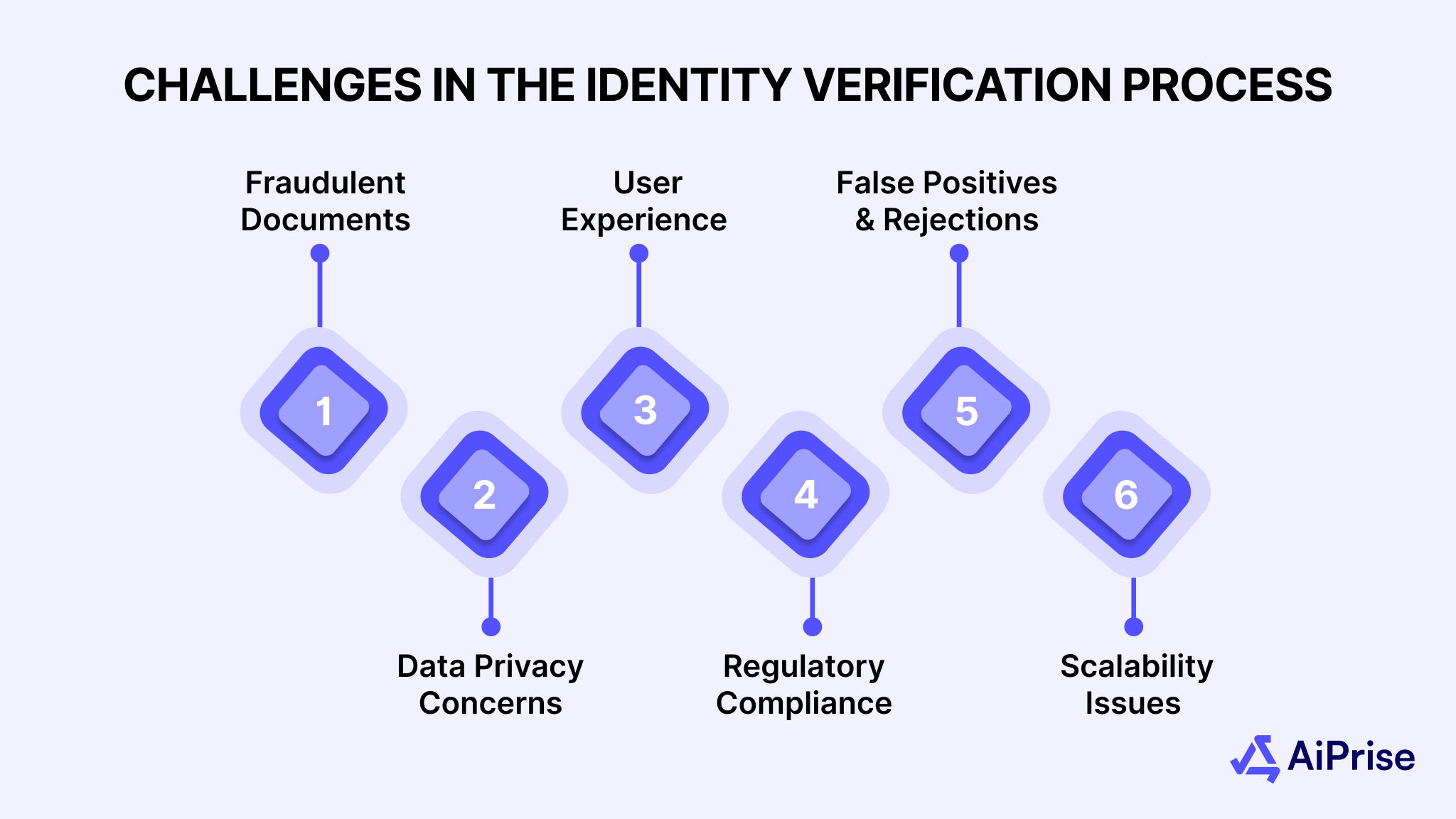
Although identity verification is crucial, it comes with its own set of challenges. Many businesses find it difficult to implement a process that’s both secure and user-friendly. Here are some common challenges:
1. Fraudulent Documents
One of the biggest challenges is dealing with fraudulent documents. Criminals often use sophisticated techniques to create fake IDs, making it difficult for businesses to detect them. Without the right technology or tools in place, fraudulent documents can slip through the cracks.
2. Data Privacy Concerns
Identity verification involves handling sensitive personal information, such as government-issued IDs and biometric data. This raises privacy concerns for both businesses and customers. Companies need to ensure that they have proper security protocols ready to prevent data breaches.
3. User Experience
A smooth user experience is important, but the verification process can often be tedious and time-consuming. If the process is too complicated, users might abandon the platform or service altogether. Balancing security with convenience is a significant challenge.
4. Regulatory Compliance
Different regions and industries have specific regulations regarding identity verification, and businesses need to comply with these regulations. Keeping up with constantly changing laws and ensuring the verification process meets those requirements can be complex and time-consuming.
5. False Positives and Rejections
Sometimes, the verification system may flag legitimate users as fraudulent due to mismatched data or minor inconsistencies. This can lead to frustrated customers who feel that they’re being unfairly rejected. Businesses need to fine-tune their verification systems to reduce false positives without compromising security.
6. Scalability Issues
As businesses grow, the volume of identity verification requests increases. Companies need scalable solutions that can handle large volumes of requests while maintaining speed and accuracy. Without a scalable system, businesses may face delays or errors in the verification process.
While these challenges can make identity verification complex, they are not insurmountable. By understanding these obstacles, businesses can better prepare to implement solutions that address them.
AiPrise: A Smarter Approach to User Verification
AiPrise provides a comprehensive solution for user identity verification, bringing together essential verification steps into one easy-to-use platform. With AiPrise, businesses can confidently onboard users while ensuring security, compliance, and fraud prevention every step of the way.
Here’s how AiPrise can support your identity verification process:
Onboard Your Users with Confidence
AiPrise makes onboarding simple by combining key verification methods in one place:
- Document Verification: Confirms that the provided IDs are genuine and valid.
- Face Liveness Detection: Verifies that the user is physically present, reducing the risk of fraud.
- AML (Anti-Money Laundering): Cross-checks user data against global watchlists to detect illegal activities.
- Address Verification: Ensures the user's address matches official records.
- Fraud Detection: Uses AI to spot suspicious activity and prevent potential fraud.
AiPrise simplifies the identity verification process, helping businesses stay secure and build trust with customers.
Learn More About AiPrise’s User Verification
Final Thoughts
Identity verification is an important aspect of safeguarding your business, ensuring compliance, and building trust with customers. As the digital landscape continues to grow, businesses need to adapt and invest in robust verification systems to mitigate fraud and protect their operations.
If you’re looking to improve your identity verification process, AiPrise offers comprehensive solutions to help you verify users quickly, securely, and accurately. Take the first step in securing your business with AiPrise’s advanced fraud detection and KYB solutions. Book A Demo with AiPrise today!
Frequently Asked questions (FAQs)
1. What is the difference between identity verification and identity authentication?
Identity verification confirms a person’s identity by matching their details with trusted records, while authentication ensures they are who they claim to be during a transaction or session.
2. Why is user identity verification important?
It helps prevent fraud, ensures compliance with laws like KYC/AML, and builds trust by confirming the legitimacy of individuals.
3. How long does the identity verification process take?
The process can take anywhere from a few minutes to several days; this depends on the level of verification required and the platform used.
4. Can AI be used for identity verification?
Yes, AI is widely used to validate documents, perform biometric checks, and match data against trusted databases to ensure accuracy and speed.
5. What are the common challenges in the identity verification process?
Common challenges include document forgery, identity theft, and the complexity of verifying identities across different jurisdictions.
You might want to read these...

Aiprise has helped streamline our KYB (Know Your Business) flow in 100+ countries. No other tool comes close.





Speed Up Your Compliance by 10x
Automate your compliance processes with AiPrise and focus on growing your business.




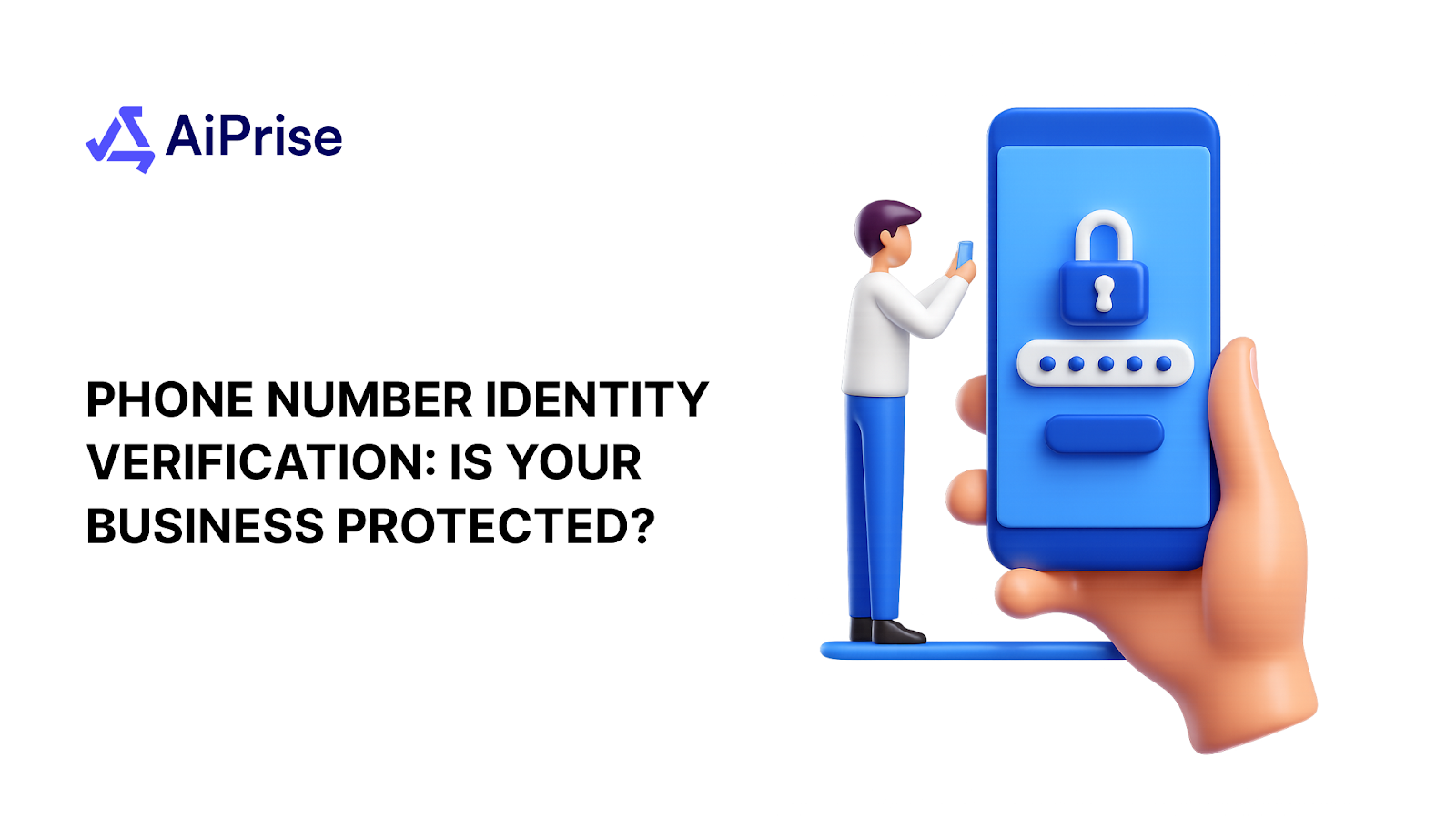
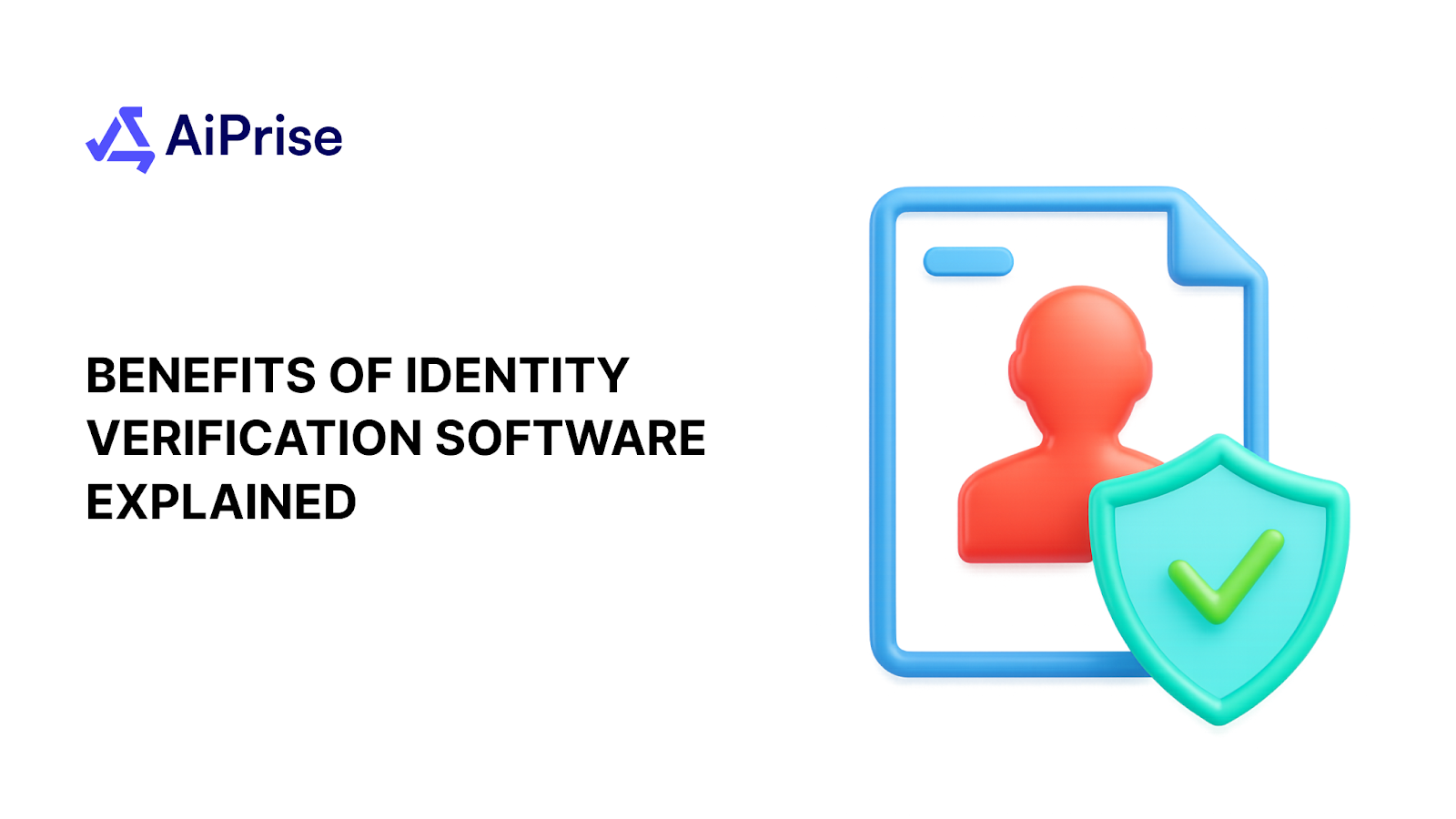
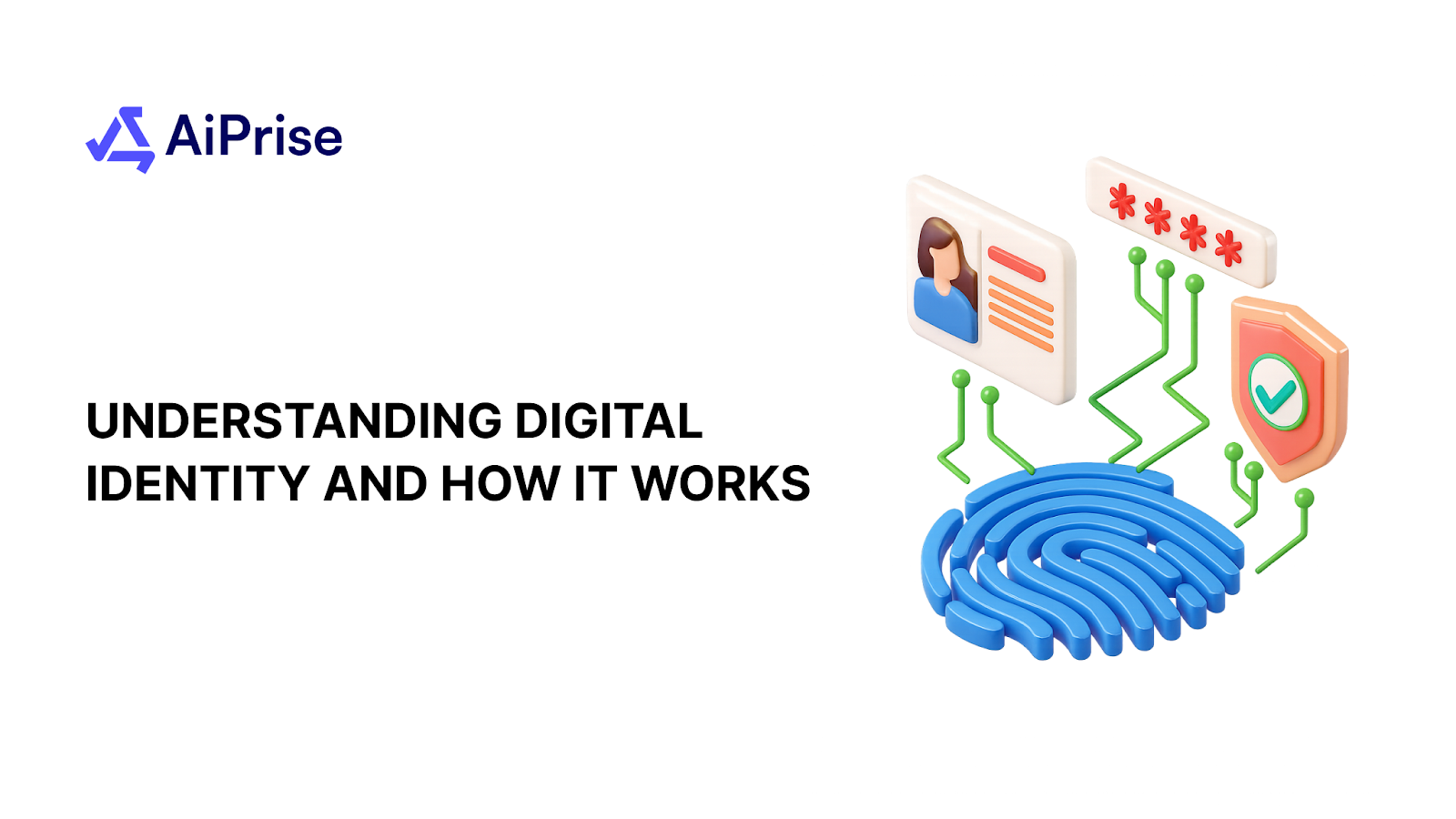
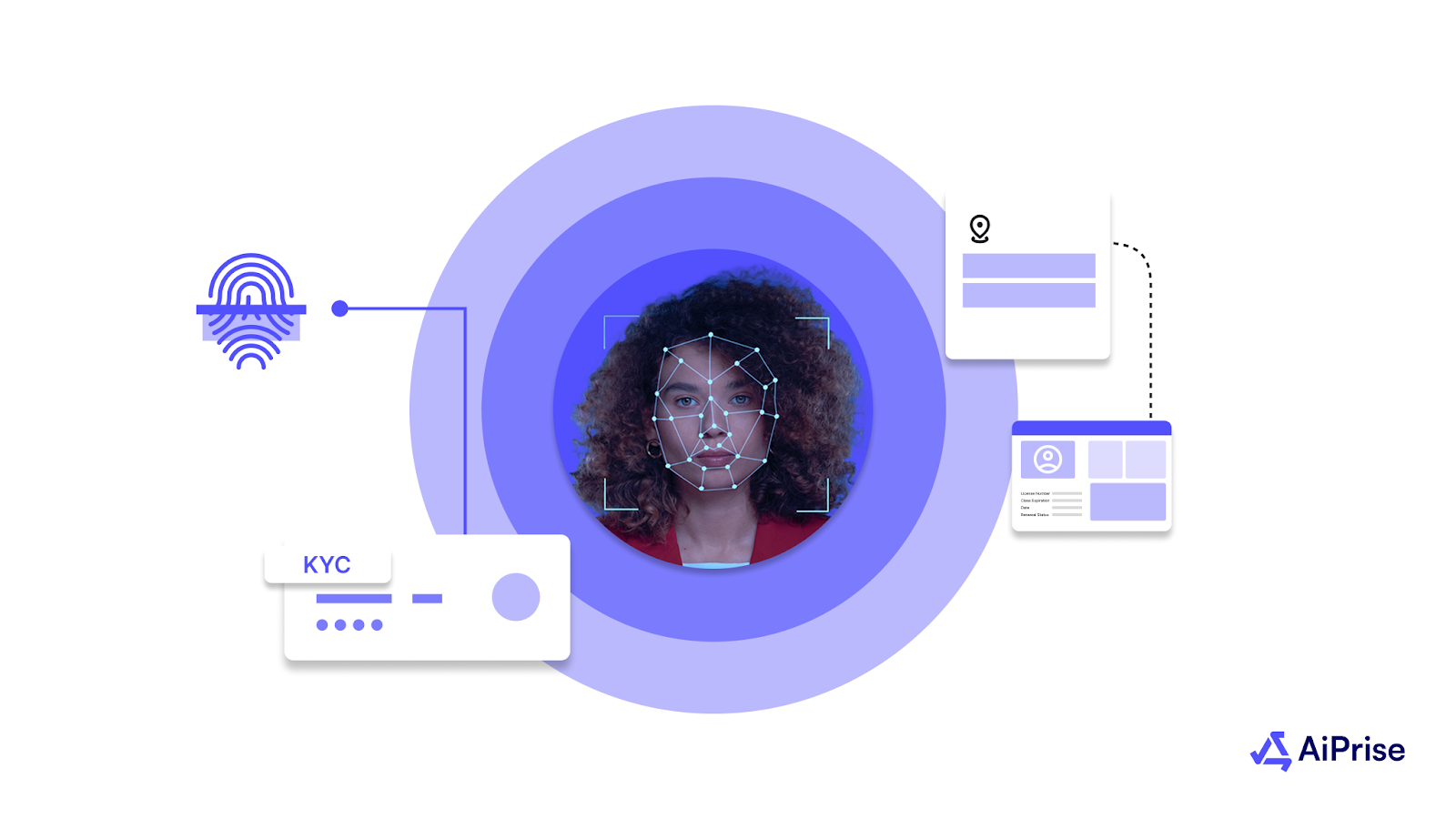
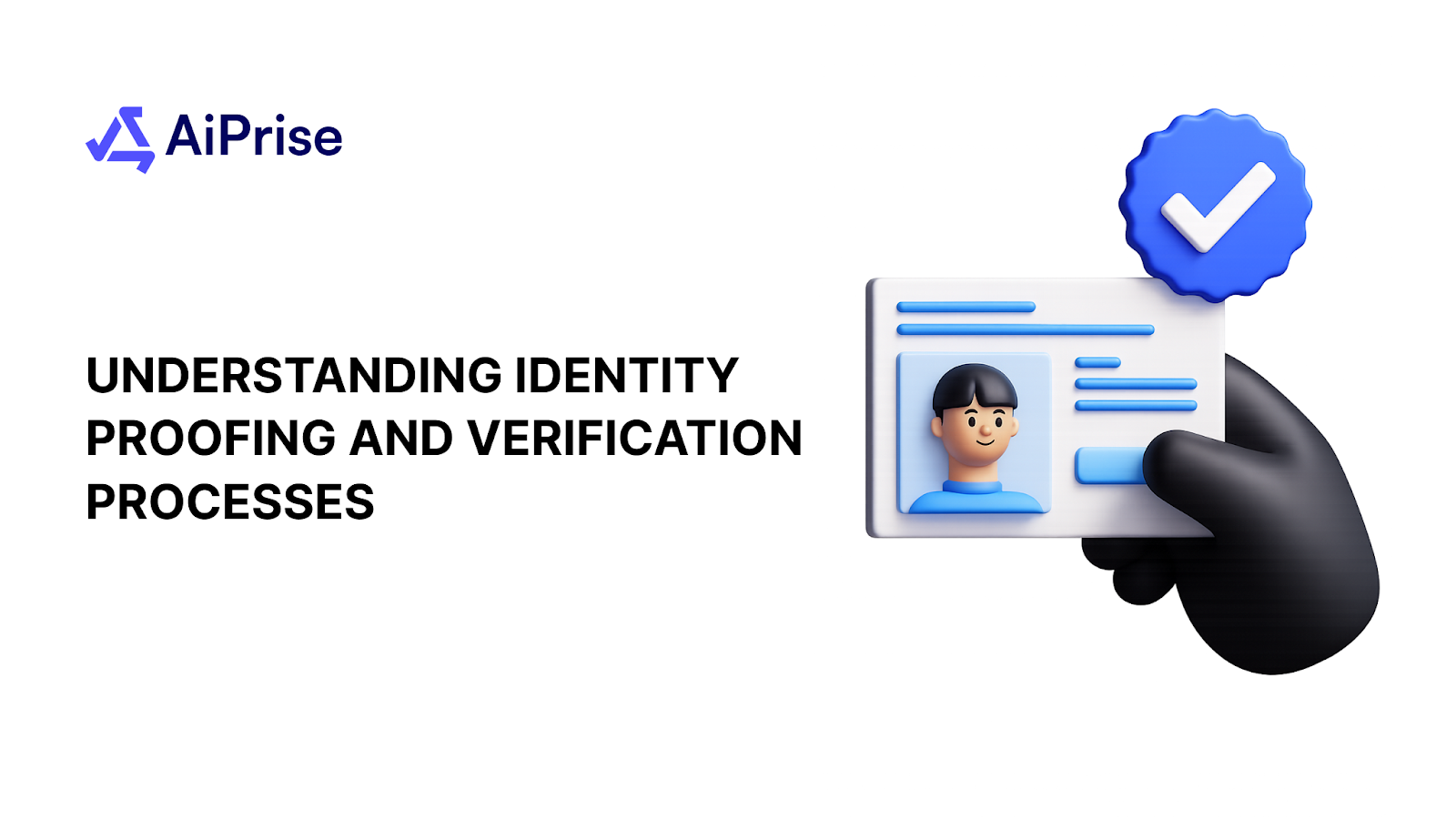
.png)




